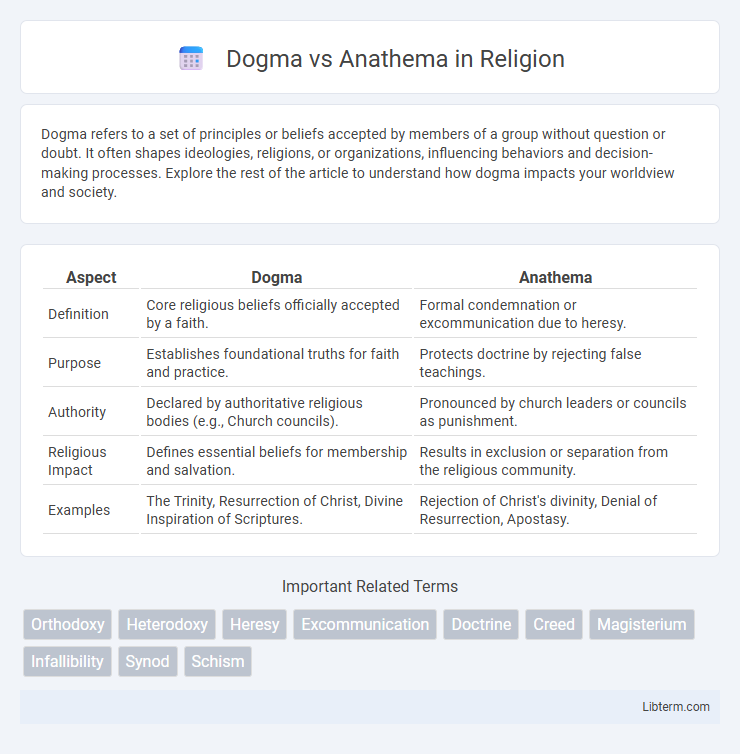Dogma refers to a set of principles or beliefs accepted by members of a group without question or doubt. It often shapes ideologies, religions, or organizations, influencing behaviors and decision-making processes. Explore the rest of the article to understand how dogma impacts your worldview and society.
Table of Comparison
| Aspect | Dogma | Anathema |
|---|---|---|
| Definition | Core religious beliefs officially accepted by a faith. | Formal condemnation or excommunication due to heresy. |
| Purpose | Establishes foundational truths for faith and practice. | Protects doctrine by rejecting false teachings. |
| Authority | Declared by authoritative religious bodies (e.g., Church councils). | Pronounced by church leaders or councils as punishment. |
| Religious Impact | Defines essential beliefs for membership and salvation. | Results in exclusion or separation from the religious community. |
| Examples | The Trinity, Resurrection of Christ, Divine Inspiration of Scriptures. | Rejection of Christ's divinity, Denial of Resurrection, Apostasy. |
Understanding Dogma: Definition and Origins
Dogma refers to a set of authoritative beliefs or doctrines established by a religious or ideological group, often considered incontrovertibly true and requiring adherence by its followers. Originating from the Greek word "dogma," meaning "that which seems good" or "opinion," dogma has historically been used to unify communities under a common theological or philosophical framework. Its role is to define core principles that guide faith, morals, and practice within specific traditions, distinguishing accepted teachings from dissenting views labeled as anathema.
Decoding Anathema: Meaning and Implications
Decoding anathema reveals its role as a formal denunciation or curse, often used within religious contexts to condemn doctrines or individuals opposing established dogma. Its implications extend beyond mere disapproval, signaling severe exclusion or ostracism from a community or belief system. Understanding anathema is crucial for grasping theological conflicts and the rigid boundaries set by dogmatic authority.
Historical Evolution of Dogma
The historical evolution of dogma reflects its development as official doctrines within religious traditions, crystallizing core beliefs to unify followers and define orthodox practice. Over centuries, key dogmas emerged through ecumenical councils, such as the Nicene Creed in 325 AD, which established foundational Christian theology about the nature of Christ and the Trinity. This formalization contrasted with anathemas, which labeled heretical beliefs and served to protect doctrinal purity by condemning deviations from established dogma.
Anathema in Religious and Secular Contexts
Anathema in religious contexts refers to a formal ecclesiastical curse or excommunication, often directed at heretical beliefs or practices, explicitly separating the individual or idea from the faith community. In secular contexts, anathema denotes something or someone vehemently disliked or shunned, representing a social or cultural taboo. Both uses emphasize strong disapproval or condemnation but differ in their institutional application and consequences.
Key Differences Between Dogma and Anathema
Dogma refers to established beliefs or doctrines officially endorsed by a religious or ideological authority, whereas anathema signifies a formal curse or condemnation against those who reject or oppose these doctrines. Dogma serves as foundational truths upheld by a faith community, while anathema operates as a punitive declaration excluding dissenters from that community. The key difference lies in dogma representing accepted doctrine, and anathema representing the denouncement and exclusion of opponents to that doctrine.
The Role of Dogma in Shaping Belief Systems
Dogma serves as the foundational set of principles that define and unify a belief system, providing clear guidelines for adherents' faith and practice. It establishes authoritative truths considered essential and non-negotiable, shaping moral conduct and community identity. In contrast, anathema signifies beliefs or practices condemned and excluded, reinforcing boundaries created by dogma to maintain doctrinal purity.
Social Consequences of Anathema
Anathema, as a social sanction, ostracizes individuals or groups, leading to exclusion from community activities and loss of social support networks. This rejection often results in stigmatization, weakening social cohesion and fostering conflict or isolation. The enforcement of anathema reinforces group norms by marking deviance, but it can also provoke resistance and social fragmentation within the affected society.
Case Studies: Dogma and Anathema in Practice
Case studies of dogma versus anathema reveal contrasting impacts on religious and cultural cohesion, with dogma often solidifying communal beliefs around core doctrines like the Nicene Creed in Christianity. Anathema practices, such as the early Church's excommunication of heretics in the 4th century, illustrate how societies enforce doctrinal boundaries to maintain orthodoxy. These examples demonstrate the dynamic tension between accepted dogma as foundational truth and anathema as a tool for social and theological exclusion.
Challenging Dogma: Reform and Resistance
Challenging dogma often sparks reform and resistance as individuals question established beliefs and advocate for change within religious or ideological systems. Reform movements seek to reinterpret or update dogmatic teachings to align with contemporary values, while resistance groups aim to preserve traditional doctrines against perceived threats. This dynamic interplay highlights the tension between progressive adaptation and conservative preservation of core principles.
Contemporary Relevance: Dogma vs Anathema Today
Dogma represents core principles or beliefs widely accepted within religious, philosophical, or ideological frameworks, shaping communities and guiding practices in contemporary society. Anathema denotes ideas or actions completely rejected or condemned, often influencing social cohesion and cultural boundaries by delineating unacceptable beliefs. In today's diverse and pluralistic environment, understanding the interplay of dogma and anathema is crucial for navigating conflicts, fostering tolerance, and promoting dialogue across differing worldviews.
Dogma Infographic

 libterm.com
libterm.com